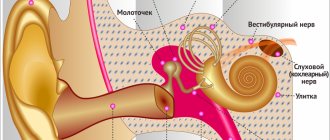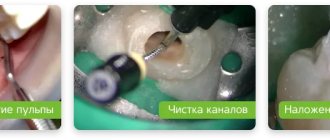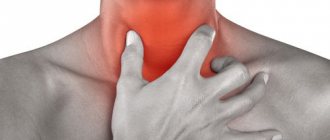Ear pain - mild or intense, shooting or aching - is a symptom that can indicate both a disease of the hearing organ and pathological processes occurring in nearby organs and tissues. According to statistics, otitis media is the most common cause of ear pain. However, the diversity of its forms and many other diseases with similar symptoms require accurate diagnosis and different treatment approaches. To establish the true causes of ear pain, it is necessary to be examined by an otolaryngologist, and sometimes by a neurologist, dentist, and even a cardiologist.
At CELT you can consult an otorhinolaryngologist.
- Initial consultation – 3,000
- Repeated consultation – 2,000
Make an appointment
Otitis externa
Most often, inflammation of the outer ear is bacterial in nature.
The causes of infection may be:
- trauma to the external auditory canal, for example, from a sharp or blunt object, or from a hearing aid;
- skin defects due to eczema, psoriasis, diabetes and other diseases;
- too thorough removal of earwax, which creates an acidic environment that prevents the growth of microbes;
- frequent entry of water into the outer ear (“swimmer’s disease”).
Symptoms of external otitis:
- acute ear pain, aggravated by pressing on the tragus or pulling the earlobe;
- possible itching and a feeling of “stuffiness” in the ear;
- discharge of a purulent or bloody nature, sometimes having an unpleasant odor;
- examination reveals swelling and hyperemia of the external auditory canal;
- possible hearing loss;
- enlargement and tenderness of the lymph nodes in the neck and behind the ear on the affected side.
The course of the disease may be complicated by a perforation of the eardrum, which cannot be determined without a visit to an ENT specialist.
External otitis of fungal origin is a common phenomenon, usually occurring in patients with low immune status or due to long-term use of antibacterial drops. It is characterized by severe itching, the formation of crusts, profuse thick discharge and the absence of a therapeutic effect from the use of antibiotics.
Separately, it is worth noting the localization of a boil on the skin of the external auditory canal or inflammation of the atheroma. The clinical picture is similar to otitis externa, but upon examination there is a more localized focus of inflammation with an opening from which pus and blood can be discharged.
Otitis media
The middle ear communicates with the nasopharynx through the Eustachian tube, through which infection can penetrate from the upper respiratory tract due to acute respiratory viral infections, influenza, sore throat, rhinitis, sinusitis and other diseases. Children are especially often affected because their Eustachian tube is short and wide, which makes it easier for infection to enter. The process can be one- or two-way.
Symptoms of acute otitis media:
- pain in the ear from moderate to severe, pulsating in nature (pain does not depend on pulling the lobe or pressing on the ear canal);
- increased body temperature;
- possible noise in the ear, dizziness, decreased hearing acuity;
- the presence of discharge (mucous, purulent, bloody) indicates a perforation of the eardrum.
With an aggressive course of the inflammatory process and the absence of adequate therapy, otitis media is fraught with such serious complications as meningitis, sepsis, intracranial abscess formation, and deafness.
Treatment of otitis media
If you have otitis media, treatment can only be prescribed by an otolaryngologist. Treatment of otitis media depends on the stage of the disease and the patient’s condition.
In acute eustachitis, treatment of otitis media is aimed at restoring the functions of the auditory tube. Sanitation of the paranasal sinuses, nose and nasopharynx is carried out in order to eliminate infection - rhinitis, sinuitis, etc.).
Vasoconstrictor nasal drops (otrivin, nazivin, etc.) are prescribed; in case of excessive mucous discharge from the nose, drugs with an astringent effect (collargol, protargol) are prescribed. Catheterization of the auditory tube is carried out using aqueous solutions of corticosteroids, and pneumomassage of the eardrums.
In the stage of acute catarrhal otitis media, catheterization of the auditory tube is carried out with the introduction of aqueous solutions of corticosteroids and antibiotics (penicillins, cephalosporins) into the cavity of the middle ear. Local anesthesia is prescribed (otipax drops, Anauran, Otinum). An intra-ear endaural microcompress according to Tsytovich is carried out: a cotton or gauze turunda soaked in a drug with an analgesic and dehydrating effect is inserted into the external auditory canal. Painkillers with an antipyretic effect (nurofen, solpadeine, etc.) are also prescribed. If there is no effect from symptomatic therapy, antibiotic therapy is prescribed within 48-72 hours.
Purulent otitis in the pre-perforated acute stage requires the same set of procedures as in the second stage, but supplemented with the following measures:
- prescription of penicillin antibiotics (amoxicillin, etc.), cephalosporins or macrolides;
- paracentesis (incision of the eardrum) when the eardrum appears to bulge.
It is important to prevent complications of the disease at this stage. After spontaneous opening of the eardrum or paracentesis, the disease progresses to the next stage.
The post-perforation stage of acute purulent otitis media involves the following treatment regimen:
- started antibacterial therapy continues;
- catheterization of the auditory tube is performed with the introduction of corticosteroids and antibiotics;
- a thorough toilet of the external auditory canal is carried out daily - cleaning it from purulent contents;
- transtympanic infusion of drops with an antibacterial and anti-edematous effect is prescribed (alcohol-based drops (otipax, 3% boric acid solution) are not used in this case).
In the scarring stage of AOM, spontaneous restoration of the integrity of the membrane occurs, and all functions of the ear are completely restored. However, this period requires mandatory observation by an otolaryngologist: there is a danger of chronic inflammation in the middle ear, its transition to a purulent form, or the development of an adhesive scar process in the tympanic cavity. It is also possible to develop mastoiditis.
1 Audiometry in MedicCity
2 Audiometry in MedicCity
3 Audiometry in MedicCity
In case of acute otitis media, timely contact with an otorhinolaryngologist is very important. The only measure to prevent complications is correct and timely diagnostic and treatment measures for otitis media. Sometimes the consequences of acute otitis media are adhesions in the tympanic cavity (adhesive otitis media), dry perforation in the eardrum (dry perforated otitis media), purulent perforation (chronic suppurative otitis media), etc. In addition, AOM can lead to such complications as such as mastoiditis, labyrinthitis, petrositis, meningitis, sepsis, venous sinus thrombosis, brain abscess and other life-threatening diseases of the patient.
Inflammation of the inner ear (labyrinthitis)
The labyrinth is an organ of hearing and balance, is richly innervated and includes auditory and kinetic receptors, so its inflammation causes:
- severe ear pain and headaches;
- a sharp decrease in hearing, the appearance of noise, crackling, squeaking in the ear;
- dizziness, nausea, loss of orientation in space, horizontal nystagmus.
Labyrinthitis occurs as a result of the penetration of infection in various ways from different parts and cavities of the body:
- from the middle ear with untreated or advanced otitis media;
- with infected meninges during meningitis;
- with blood for diseases such as syphilis, tuberculosis, herpes;
- damage to the temporal region, the organ of hearing with disruption of the integrity of cells and blood vessels.
The disease requires immediate medical attention.
Eustachite
Eustachitis is an inflammation of the canal connecting the middle ear to the nasopharynx. The degree of pain varies. Characteristic features are:
- feeling of stuffiness in the ear;
- noise and crackling in the ear, the patient hears his voice as too loud with a weakened perception of extraneous sounds;
- sensation of water pouring into the ear.
In the absence of timely treatment, eustachitis becomes chronic, causing chronic exudative otitis media.
Ear pain of non-infectious origin
Ear tumors
Neoplasms are most often localized in the outer and middle sections; tumors of the labyrinth are an extremely rare phenomenon. Malignant formations of the outer ear are accompanied by severe pain: the pain is burning and radiates to the temple. Possible bleeding; When the ear canal is obstructed, conductive hearing loss develops. If the middle section is affected, the symptoms are similar to otitis media; a high degree of hearing loss and intense pain, increasing in the evening, should alert you. When the process spreads, symptoms of damage to neighboring structures arise: loss of orientation in space, paresis of the facial nerve, trigeminal neuralgia.
Ear injuries
- Mechanical injuries. The auricle most often suffers with the formation of lacerations and damage to cartilage. Blunt trauma to the ear usually results in a hematoma. As a result of trauma to the ear canal, the ear hurts greatly, there is a feeling of stuffiness, and bleeding is possible. Such symptoms are an indication to consult a doctor, since rupture of the eardrum and fractures of the skull bones are possible.
- Barotrauma is caused by a difference in pressure in the external environment and the cavity of the middle ear, for example, during a sharp loud sound (explosion), take-off/landing of an airplane, deep-sea immersion (diving), climbing a mountain. As a result, the eardrum is pulled inward, which is accompanied by pain, noise or ringing, and congestion in the ears. The opposite situation is also possible, when a decrease in atmospheric pressure causes the membrane to bulge outward. As a rule, unpleasant sensations go away on their own, however, if sharp pain is noted, it makes sense to check the integrity of the tympanic membrane when examined by a doctor.
- Entry of a foreign body in the form of small objects or insects causes swelling of the skin of the ear canal, itching, pain, and sometimes hearing loss. Attempting to remove a foreign object yourself can damage the eardrum.
- With burns and frostbite of the ears, **pain // of varying intensity is observed, depending on the degree of damage.
- Conventionally, ear injuries include the formation of wax plugs, which irritate the skin of the ear canal, causing discomfort and tinnitus. Removal should be carried out by an otolaryngologist.
Causes of headaches behind the ears
A headache in the ear area is a symptom of various pathologies that can cause significant harm to health. Doctors advise paying attention to the first symptoms, as diseases can progress. Painful sensations behind the ears can be accompanied by fever, hearing loss and other complaints - they must be taken into account during diagnosis.
Diseases of the hearing organ
The main reason why a headache behind the ear on the left or right is due to diseases of the hearing organ. Discomfort can be caused by inflammatory processes or damage in any of its parts. The hearing organ is divided into the outer, middle and inner ear. The outer part is represented by the auricle, ear canal and eardrum. The main function of the middle ear is to equalize pressure in the outer and inner sections. The inner ear has the most complex structure and is called the labyrinth. It is he who recognizes sound vibrations and transmits them to the cerebral cortex.
Chronic or throbbing pain in the head behind the ear may be the first sign of the following diseases:
- Otitis is an inflammation of the outer, middle or inner ear. The disease is accompanied by acute pain and discomfort. An advanced process can be complicated by purulent inflammation, in which case discharge from the ear canal appears.
- Labyrinthitis is a dangerous disease, inflammation of the labyrinth of the inner ear. The process is often one-sided, manifesting itself on the left or right side. Complaints include not only headaches, but also nausea and loss of coordination. The labyrinth is responsible not only for the perception of sounds, but also for balance.
- Meniere's disease is a pathology of non-infectious origin. Its main symptom is an increase in the volume of endolymph, the fluid in the inner ear. It is manifested by chronic unilateral pain behind the ear, nausea, and decreased hearing acuity.
- Mastoiditis is an inflammatory process that affects the process of the temporal bone. It can be caused by injury, viral or bacterial infection. It is accompanied by elevated temperature, a sharp deterioration in health, and purulent discharge from the auditory canals. The disease is more often diagnosed in children than in adults.
- Fungal diseases (otomycosis) - cause inflammatory reactions, itching and irritation. The infection most often affects the external parts of the hearing organ. In the initial stages, the fungus is not dangerous, but without treatment it can become complicated by purulent processes.
Head pain in the ear area is a dangerous phenomenon, since it may indicate various diseases of the hearing organ. Pathological processes without timely treatment spread to the internal parts. Air deficiency and the presence of endolymph provide a favorable environment for the development of bacterial infection. Its development is dangerous due to purulent inflammation, which can cause damage to the membranes of the brain and deterioration of hearing until it is completely lost.
Infectious diseases
Seasonal colds, acute respiratory viral infections and influenza are common diseases that affect adults and children. They are caused by a viral infection and are transmitted through airborne droplets and household routes. They can be recognized by their characteristic features:
- headaches behind the ears, as well as in the forehead and back of the head;
- increase in body temperature to 37 degrees or more;
- nasal congestion, swelling of the mucous membranes;
- cough, sore throat, redness and soreness;
- general weakness, drowsiness, decreased performance.
With viral diseases, the temperature rises already in the first days after the infection becomes active. This sign, combined with pain in the head near the ear, indicates the need to stay in bed, drink plenty of fluids and take supportive medications. However, if your health suddenly deteriorates, self-medication will be harmful. Even a common cold can be complicated by pneumonia or spread to the membranes of the brain if the immune system is weakened and cannot cope with the infection.
Other reasons
If your head hurts behind your ears, this may indicate various disorders. This symptom accompanies various infectious and non-communicable diseases that occur in acute or chronic forms. As a result of the diagnosis, pathologies may be detected that require urgent treatment.
- Migraine is a chronic disease that manifests itself as a one-sided headache, but can affect the entire surface of the head. Its exacerbation can be caused by hormonal changes, changes in atmospheric pressure, stress and other reasons. Migraine is often diagnosed in middle-aged women.
- Lymphadenitis is inflammation of the lymph nodes. In the ear area there are auricular, occipital and cervical lymph nodes. They can become inflamed due to previous infectious diseases, as well as with pathologies of the immune system. Superficial nodes are felt under the skin in the form of round, painful, dense formations. In an acute process, redness of the skin over the affected area and an increase in general body temperature may be observed.
- Shingles is a fungal disease that is transmitted by contact. Its pathogen can also be found on towels, bedding and other household items that come into contact with the skin. It causes pain, inflammation, severe itching, redness and peeling of the skin in the neck, back of the head and ears. The disease causes acute headaches, lumbago in the muscles and a general deterioration in well-being.
- Neuralgia is pain associated with inflammation or damage to the nerves. Headaches behind the ear are associated with the trigeminal nerve, which carries branches to the skin of the face and scalp. The causes of neuritis are hypothermia, previous viral diseases, injuries to the cervical spine and other factors.
- Arthritis or arthrosis of the temporomandibular joint is a pathology that causes unilateral acute pain behind the ear. It intensifies during chewing, talking and any jaw movements. Diseases can be caused by injuries, dental problems, and infectious agents.
- Neoplasms inside the auricle are a surgical pathology. During diagnosis, boils, tumors and other formations may be detected that cause pain and itching and cause hearing impairment. Their timely removal will restore normal health and prevent complications.
- Dental diseases are one of the common causes of ear pain. Caries, incorrect position of teeth and other pathologies can cause destruction of surrounding tissues and acute pain.
A headache that affects the area behind the ears can occur even in the absence of serious problems. It occurs when you are very tired, after intense physical activity, or due to stress. In some cases, symptoms disappear after proper rest, restoration of sleep patterns, and also as a result of proper nutrition. However, if the headache occurs frequently, it is important to seek medical help.
Ear pain due to diseases of other organs
- Mastoiditis - inflammation of the mastoid process - causes intense throbbing pain in the ear, swelling of the tissue behind the auricle, hearing loss, and hyperthermia.
- With arthrosis and arthritis of the temporomandibular joint, the patient is bothered by shooting pains in the ear, which intensify when chewing, a crunching sound in the temple area, and over time, hearing impairment and malocclusion are possible.
- Mumps is an inflammation of the salivary gland located in front of the auricle, accompanied by acute pain in the ear, aggravated by swallowing and chewing, and swelling of the tissues.
- Inflammation of the parotid lymph nodes (lymphadenitis) develops when infection penetrates into them from diseased teeth or from other foci of inflammation.
- Inflammatory diseases of the nasopharynx and sinuses, malignant processes in the larynx and oral cavity are often accompanied by pain in the ear when swallowing.
- Caries, pulpitis. Since the organ of hearing, like the teeth, is innervated by the branches of the trigeminal nerve, damage to the teeth and jaw may be accompanied by pain in the ear area.
- An atypical form of heart attack, when the patient’s only subjective complaint is pain in the ear.
Treatment of otitis media during pregnancy
If you experience ear pain during pregnancy, you should urgently see an ENT doctor. Remember that in this case you cannot apply heating pads or warm compresses to the sore spot! This can be very dangerous if purulent inflammation begins in the ear.
If the pain increases and greatly bothers a pregnant woman, and there is no way to see a doctor in the near future, you can take several independent steps. For example, you should put vasoconstrictor drops into your nose.
Diagnostics
The diagnosis and treatment of pathologies associated with this symptom is carried out by an ENT doctor (otorhinolaryngologist) or an audiologist (a narrower specialty in otorhinolaryngology). During the appointment, the specialist talks with the patient, examines him, conducts the necessary examination, and establishes a diagnosis.
The multidisciplinary CELT clinic employs experienced, highly qualified otolaryngologists. Rich clinical experience helps them make the correct diagnosis in the most difficult cases.
Treatment
Treatment of inflammatory ear diseases includes:
- antibacterial, antiviral agents of local and general action;
- antipyretics, analgesics;
- physiotherapy;
- in some cases - surgical intervention.
Treatment must be based on accurate diagnosis, which is impossible outside a specialized clinic. The high professionalism of CELT specialists allows us to identify various diseases of the hearing organ and choose the most effective means of solving the problem.
Make an appointment through the application or by calling +7 +7 We work every day:
- Monday—Friday: 8.00—20.00
- Saturday: 8.00–18.00
- Sunday is a day off
The nearest metro and MCC stations to the clinic:
- Highway of Enthusiasts or Perovo
- Partisan
- Enthusiast Highway
Driving directions
Temporal arteritis
The disease is an inflammation of the vessels of the temporal artery.
If the inflammatory process spreads to the ear artery, the patient will also experience pain in the ears. This disease is typical for older women. It causes blurred vision, headaches, pain in the temples, and increased fatigue. Make an appointment right now! Call us by phone or use the feedback form
Sign up
Along the branches of the vagus nerve, pain can radiate to the ear from the esophagus, thyroid gland, and organs of the cardiovascular system.
If you have ear pain, you should definitely consult with an otolaryngologist, since this condition may signal the presence of serious diseases in the body. If the ear is healthy, no abnormalities have been identified, and the pain does not go away, it is necessary to diagnose the nose, larynx, pharynx and, if necessary, other organs to identify the cause of otalgia. Further treatment will depend on the diagnosis.







